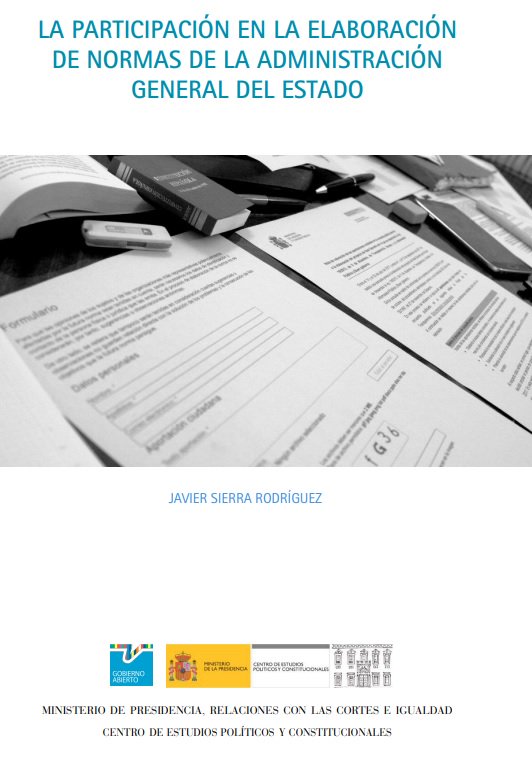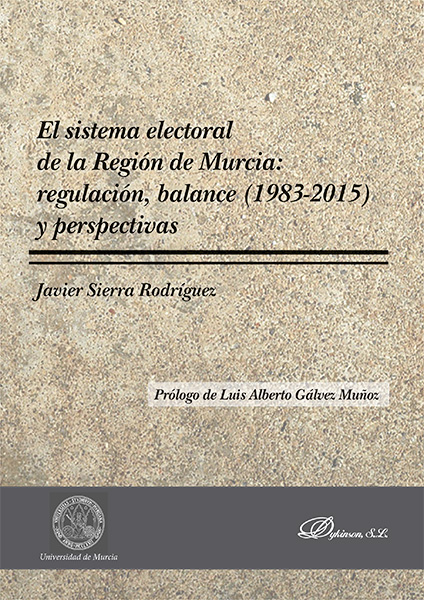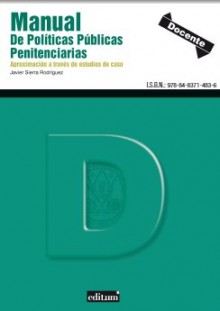La participación en la elaboración de normas de la Administración General del Estado
Título: La participación en la elaboración de normas de la Administración General del Estado
Autor: Javier Sierra Rodríguez
Editorial: Centro de Estudios Políticos y Constitucionales
NIPO: 044-19-042-4
Páginas: 271
Fecha de la edición: 2019
DESCARGA A TEXTO COMPLETO EN: http://www.cepc.gob.es/publicaciones/libros/colecciones?IDP=2773
El sistema electoral de la Región de Murcia
Título: El sistema electoral de la Región de Murcia: regulación, balance (1983-2015) y perspectivas
Autor: Javier Sierra Rodríguez
Editorial: Dykinson
ISBN: 978-84-9148-197-3
ISBN electrónico: 978-84-9148-218-5
Páginas: 281
Fecha de la edición: 2017
Edición: 1ª ed.
Manual de Políticas Públicas Penitenciarias
Título: Manual de Políticas Públicas Penitenciarias. Aproximación a través de estudios de caso.
Autor: Javier Sierra Rodríguez
181 páginas
Editum - Universidad de Murcia
ISBN: 9788483714836
Año 2011
DE VENTA EN:
En papel: Librerías Diego Marín: http://www.diegomarin.com/1199662-9788483714645-MANUAL-DE-POLITICAS-PUBLICAS-PENITENCIARIAS.html
E-Book: Enlace de compra: http://www.diegomarin.com/1198739-Manual-de-Polticas-Pblicas-Penitenciarias.html
SI LO DESEA PUEDE HACER EL PEDIDO DE LIBROS DIRECTAMENTE A LA EDITORA: https://publicaciones.um.es/publica/
PRISON POLICY MANUAL. CASE STUDIES.
Javier Sierra Rodríguez
ISBN: 978-84-8371-464-5. Editum. University of Murcia 2011.
Under the title “Prison Policy Manual: case studies”, there is a publication that combines the theoretical and methodological aspects for the analysis of the policy in Spanish prisons.
Chapter 1 is devoted to properly integrate, conceptualize and define the methodological content of the case studies in to a policy analysis.
In Chapter 2 the evolution of the prison environment will be discussed and analyzed from the end of the civil war with the main emphasis on the different periods of democracy. This chapter will describe the framework, policies and administrative structures of the main government and the government of Cataluña. What also is mentioned are the links to the resources of the prison administration and the policy for treating the challenges for the coming decades.
Chapter 3 contains an overview of the different people involved in the prison policy and describes how the different people use different systems and subsystems to work in the prison environment. This chapter shows the diversity of stakeholders, political parties, institutions and government agencies, ombudsmen, trade unions, private organizations and technical agencies.
Chapter 4 focuses on the overpopulation in the Spanish prisons. This is discussed by means of key demographics of the prison (age, gender and other variables), the recent development and comparison with other countries. This chapter also examines the causes of the overpopulation and there will be referred to the foreign prison population and the guidelines of the STS-107/2006.
In chapter 5 the jail facilities and related topics will be described such as the different types of prisons, the units and the internal organization. This chapter concludes with a case study on the construction of the prison “Campos del Río” in Murcia.
In chapter 6, the final chapter, the policies about, the ETA prisoners, spreading prisoners and the financial support of the Basque government for family visits will be discussed.
HANDBOEK GEVANGENIS BELEID. AANPAK DOOR MIDDEL VAN CASE STUDIES. Traducción por Sebastiaan van der Starre
Javier Sierra Rodríguez
ISBN: 978-84-8371-464-5. Editum. Universiteit van Murcia 2011.
Onder de titel “Handboek Gevangenis Beleid: aanpak door middel van case studies”, is er een middel dat de theoretische en methodologische aspecten combineert voor de beleidsanalyse van de Spaanse gevangenis.
Hoofdstuk 1 is gewijd aan het naar behoren integreren, conceptualiseren en definiëren van de methodologische inhoud en case studies van de beleidsanalyse.
In hoofdstuk 2 wordt de Spaanse gevangenis-systeem besproken, geanalyseert hoe de evolutie verliep van de gevangenis milieu sinds het einde van de burgeroorlog met een grote nadruk op de verschillende periodes van de democratie. In dit hoofdstuk wordt het regelgevende kader, het beleid en de administratieve structuren van zowel de centrale regering als de regering van Cataluña behandeld. Ook heeft dit hoofdstuk verwijzingen naar de hulpbronnen van de gevangenis administratie en behandeld de aanpak voor de uitdagingen van de komende decennia.
Hoofdstuk 3 is een overzicht van de verschillende personen die een rol hebben in het gevangenis beleid en er word onderzocht hoe de verschillende personen op basis van verschillende systemen en subsystemen werken in de gevangenis omgeving. Dit hoofdstuk geeft de diversiteit weer van de betrokken partijen, onder anderen: politieke partijen, instellingen en overheidsinstanties, ombudsmannen, vakbonden, particuliere organisaties en technische agentschappen.
Hoofdstuk 4 gaat dieper in op de overbevolking in de Spaanse gevangenissen. Dit wordt besproken door middel van de belangrijkste demografische gegevens van de gevangenissen (leeftijd, geslacht en andere variabelen), de recente ontwikkeling en de vergelijking met andere landen. In dit hoofdstuk word ook ingegaan op de oorzaken van de overbevolking en verwezen naar de buitenlandse gevangenis bevolking en de richtlijnen van de STS-197/2006.
In hoofdstuk 5 worden de gevangenis faciliteiten en aanverwante onderwerpen besproken zoals de verschillende type gevangenissen, de eenheden en de interne organisatie hiervan. Dit hoofdstuk wordt afgesloten met een case studie over de bouw van de gevangenis “Campos del Río” in Murcia.
Tot slot wordt er in hoofdstuk 6 ingegaan op het beleid met betrekking op ETA gevangenen, het beleid van het verspreiden van gevangenen en de financieële steun van de Baskische regering voor familiebezoeken.
- libros.txt
- Última modificación: 2019/11/30 14:34
- (editor externo)


